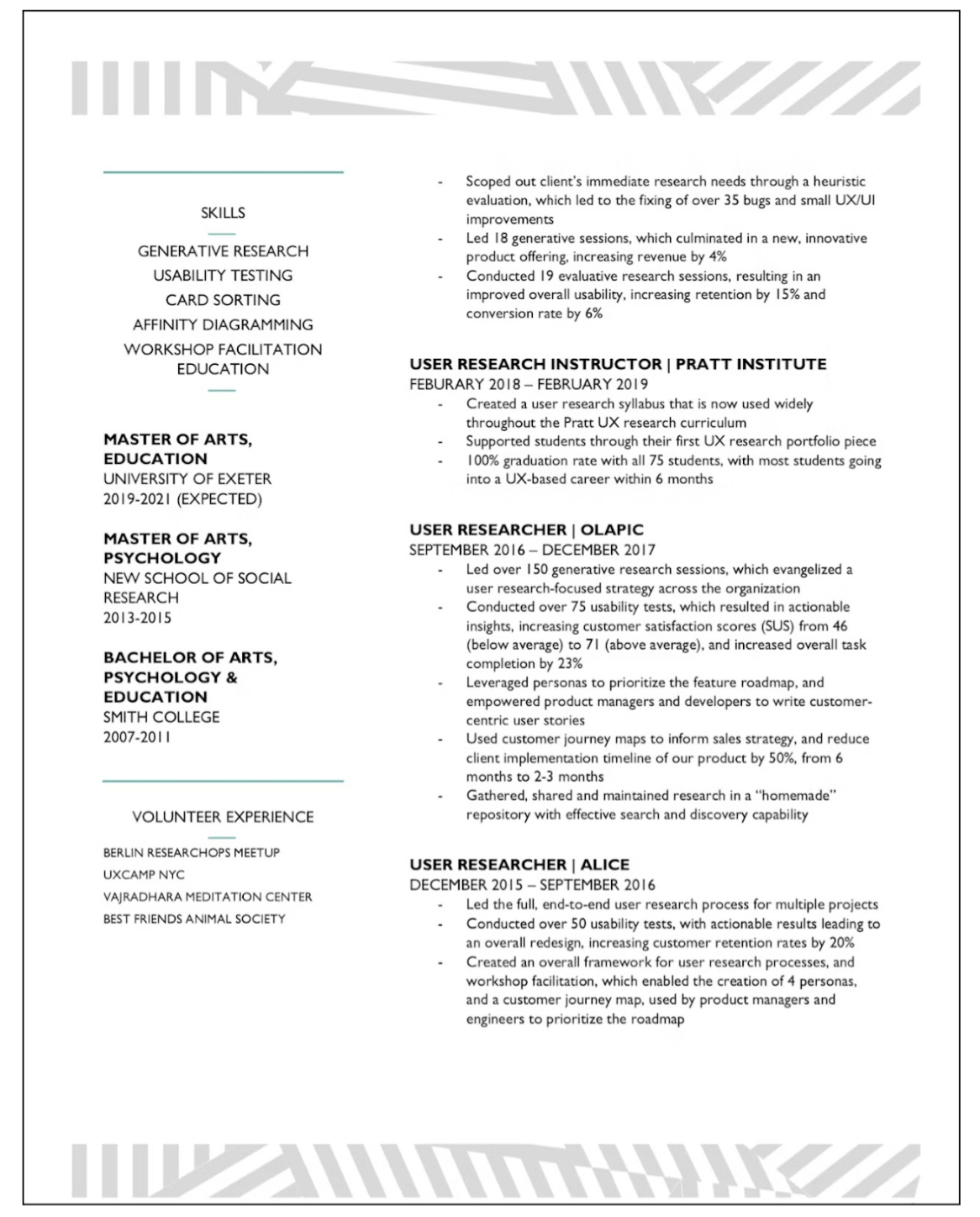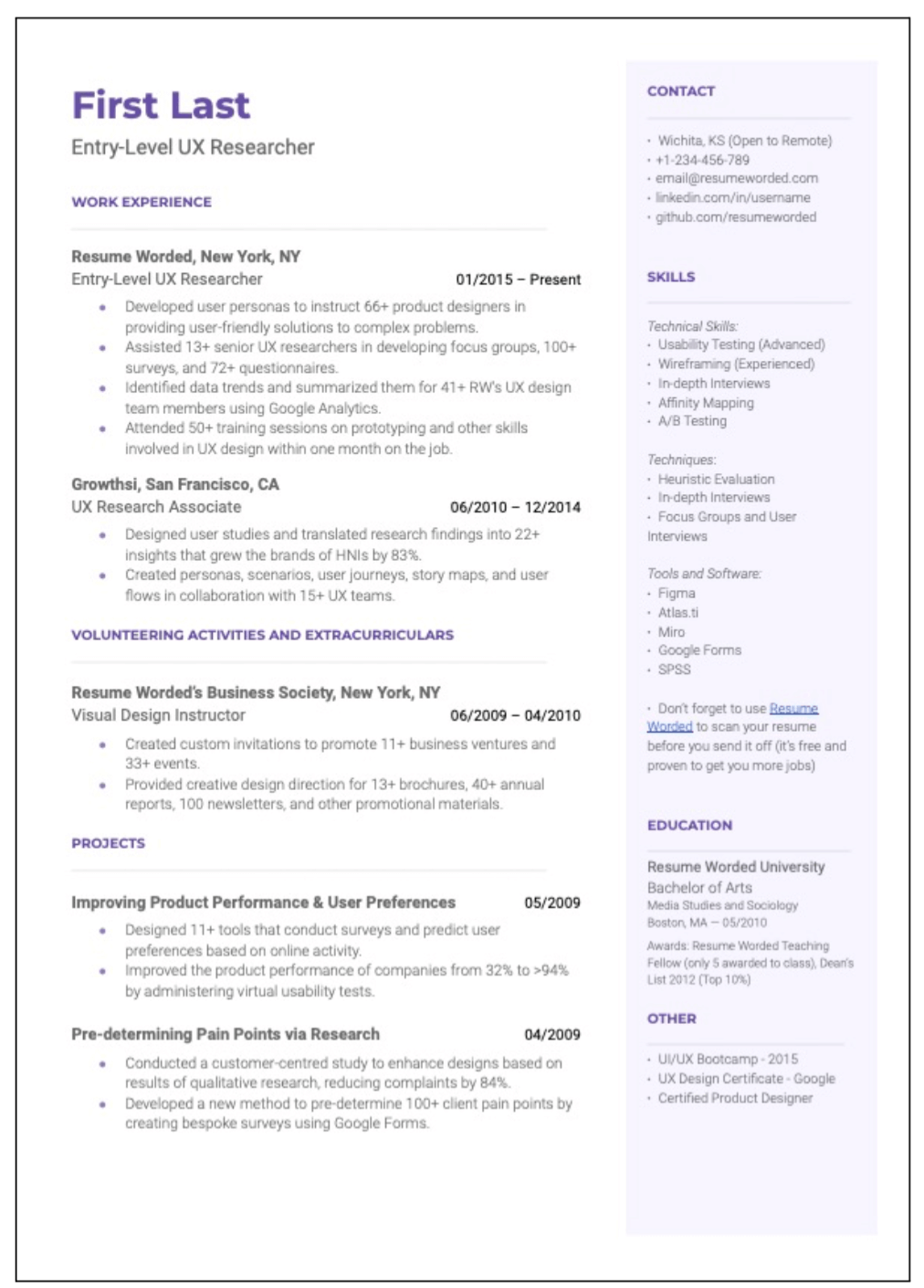You know you need a resume to get a role as a UX researcher. After all, this is the first thing recruiters or hiring managers will look at for any job you apply for. But what makes a resume good rather than just okay? In other words, what kind of resume will get hiring managers to call you rather than getting your resume tossed in the trash?
You can’t just list your tasks and responsibilities or optimise your resume with some choice keywords. Your resume needs to showcase your skills in UX research while explaining the impact you’ve had on organisations. We’ll show you how.
What do hiring managers look for in a UX researcher’s resume?
UX research is an in-demand skill. For instance, LinkedIn has consistently ranked research as one of the top 10 most in-demand skills. In addition, in UX Design Institute’s State of UX Hiring Research Report 2024, a full 50% of those responsible for hiring thought they’d hire UX researchers. That’s second only to UX designers. And while a research portfolio is essential as well, the resume is what gets you through the door to the interview. As a result, you need a great resume to send to hiring managers.
General resume advice
This resume should include some general things that all resumes should include, like:
- Readability – Don’t use fancy fonts and cute images. Instead make things readable by ensuring the writing is crisp, clean, and clear. Don’t cram in text. Instead make sure there’s enough white space to ensure comfortable reading.
- Scannability – You should make your resume easy for hiring managers to skim for key information. Include proper spacing and room between sections so that information can be easily found and quickly read.
UX researcher resume advice
In addition, there are a bunch of things specific to a UX researcher that should be included in your resume. These include:
- Your approach to research problems – You should include your thinking and explain why you approached a particular problem the way you did
- Examples of the impact your work had on the organization – If you got 30% more people to stay 20% longer on a website you did research for, say it!
- Details of your collaborations with others – You should explain how you collaborated with the project managers, the UX designers, the UI designers, the developers, and anyone else who participated in the project.
- What you’ve done at every stage of the UX research lifecycle – This can include research-specific things, including specific quantitative or qualitative methodologies you might have used, as well as skills that are outside of research but no less crucial to the job, including leadership, facilitation, and creative strategy.
- Make sure to highlight the software and methodologies you used – This can include Sketch, Figma, Adobe XD, quantitative methods like A/B testing, qualitative methods like user interviews, and anything else you use for UX research. This should be included in a “Skills” section. If the section is extensive it can be divided by software and methods.
If you’re just starting out
A lot of the things mentioned above can be a breeze to find examples of for someone whose well into their career as a UX researcher. However, it can be much harder if you’re just starting out. You may not have the experience as a UX researcher where you’ve had an impact on an organization or collaborated with others.
For that reason, we suggest adding a Projects section that can serve as a bridge to the job description. Here you can show things that speak to your enthusiasm for the job of a UX researcher that aren’t necessarily employment, such as projects completed for classes, design competitions, or on a voluntary basis. After the Projects section you can add the Employment Experience section but, as much as possible, try to keep this relevant to UX research by emphasizing things that fit the job description of the company you’re hiring for.
How to structure and format your UX researcher resume
What format should you go with?
Generally speaking, you’ll want to format your resume as a PDF when you send it to hiring managers. That format means the document won’t change when you send it through. However, on occasion, hiring managers may ask for Word (.doc), Rich Text Format (.rtf), or even plain text (.txt). Accommodate them and do your best to make sure that your resume will still wow them in these formats.
The importance of spacing
Make sure to include proper spacing between sections, lines, and words in your resume. This is essential for your resume’s scannability but it’s also essential for placing the right amount of emphasis on each section of your resume.
Your line spacing should be either 1 or 1.15 with 6-12 pts spacing after each major section and 3-6 pts after each job or educational entry. While we’ve been fairly specific about what spacing to use, you still have choices, and the choices you make are part of your personal aesthetic in your resume.
Sections to include
From a practical standpoint, you should include the following sections in your resume in roughly the order we’re outlining. They include:
Contact information
This should include your name, city and state, phone number, and email address and should be right at the top of your resume. Also be sure to include a link to your online UX research portfolio. Go here to learn how to create a stand-out portfolio.
Summary
While this section isn’t required, it is strongly encouraged. It’s a brief section of no more than a paragraph that conveys information relevant to the job you’re applying for, such as experience you have, parts of your background, or what your perspective is on the field.
Experience
List all your professional experience in reverse chronological order — that means your most recent job should be first. This shouldn’t be everything your ever did. Only the most relevant jobs you’ve had should be included. First, put your title, the company, the dates you worked there, and the location. This should be followed by a brief paragraph or a few bullet points describing each position. Here, you should include things like who you collaborated with, the impact you had on the organization, and your approach across the research lifecycle.
If you’re very early in your career this doesn’t have to include only professional experience. If you have relevant experience in extracurricular activities or you did the research for your friend’s website for free over a period of time, you may want to put those here too. Also, if you’re a career changer and have jobs that are not in UX research but may have relevant transferable skills, such as critical thinking or problem-solving, include them here too.
Projects
While this section isn’t required, it may be relevant especially if you’re early in your career. Here you can list any projects that you played a major role in including during design competitions, on a voluntary basis, or for an internship.
You may even want to place this section before the experience section if this section has more relevant information in it.
Skills
You should list all the technical skills and tools you use here. This can include methodologies like quantitative and qualitative research and tools such as Sketch, Invision, and Figma. You never want to lie on your resume, but if the job ad mentions skills and tools you know how to use, make sure to mention those toward the top of the section.
Awards, Volunteer experience, etc.
These sections aren’t mandatory but if you happen to have gotten an award, given a presentation at a conference, mentored others, or anything else that has gone above and beyond in the field, mention it in one of these sections.
Education
You should include your degrees and any relevant classes or certificates you’ve gotten here. For example, if you just got UX Design Institute’s Professional Certificate in User Research, that should be at the top of your list with any Bachelor’s and Advanced degrees further down.
However, if you got your degrees a while ago and are well into your career, you can just list them briefly at the bottom of your resume. You don’t even have to include the dates if you prefer.
Top tips for perfecting your UX researcher resume
You can perfect your UX researcher resume with some practical tips.
Make sure to highlight key skills from the job ad
Ensure you highlight the relevant skills listed in the job ad by putting them in your resume. It doesn’t pay to lie, but if the hiring manager asks for skills, like card sorting and usability testing, for example, and you know how to do those, make sure to mention them either in your Experience or Skills section or both. And make sure to check out our article on how to find UX research jobs.
Optimise your resume for Applicant Tracking Systems
Nowadays most companies scan your resume to a computer to include in their Applicant Tracking System or ATS. To get the most out of this situation there are a few things you should do, including:
- Use keywords. A careful review of the job description should give you an idea of what keywords and qualities the employer is specifically targeting and this should help you weave these into your resume.
- Use easy-to-read fonts such as Palatine, Times, and Helvetica and make sure they’re between 10 and 14 points. Don’t use Comic Sans.
- Avoid things like italics and underlining.
Don’t worry about going past a single page
If you can’t fit everything on one page, don’t worry about it. It’s better to have a two or even three-page resume than a one-page resume where everything is crammed together. That said, if it’s just one paragraph over, it’s better to figure out how to fit everything on a single page.
Check your spelling and grammar before sending your resume
Make sure to check your spelling and grammar in your resume before sending it out. Even if you’re using something like Grammarly to ensure your spelling is correct, those systems can make mistakes. It’s better to check than take the risk. There’s nothing worse than discovering your misspelling of “Adobe XD” or “qualitative” sunk your chances of getting an interview.
UX researcher resume examples and templates
Here are some examples of real UX researcher resumes and templates you can use as inspiration when creating your own.

First is a real resume by UX researcher Nikki Anderson. She’s very experienced so her column on the right-hand side is extensive. On the smaller left-hand side is everything else she needs in the resume including her skills, volunteer experience, and a brief summary that has relevant information and a little bit of fun detail.
Throughout her experience section, she uses numbers and specifics to explain what work she did, how she did it, what the outcome was, and who it helped. Also this an example of a 2-page resume for UX researchers that doesn’t waste any of the space it uses.
This is one of many resume templates on EnhanceCV. While you don’t need things like the Strengths or Passions sections, they can be handy if you need a way to show you have a certain skill. This is an especially interesting resume because it has separate Certification and Education sections. While you could put all your education under one heading, this is another way to do it, and it might save space.
This is an entry-level UX researcher resume found on ResumeWorded. It has a lot more categories than resumes for higher-level UX researchers, including Projects and Volunteering Activities and Extracurriculars in the large left-hand column. It also includes more details about the Tools and Techniques this individual knows. All this is to put your best foot forward to get a job and show that even though you may not have a lot of experience, the experience you do have is related to the job you’re applying for.
Other places to look for UX researcher resume templates that can be customized include:
Key takeaways
- In general, make sure your resume is readable and scannable.
- UX researcher resume-specific advice includes: Explain your approach to research problems; include examples of the impact your work had on the organization; detail your collaborations with others; describe what you did at every stage of the UX research lifecycle; and make sure to highlight the software and methodologies you used.
- If you’re just starting out, we recommend including a Projects section that can speak to your enthusiasm for the job by showing projects you’ve done in classes, for design competitions, or as a volunteer, that isn’t necessarily employment but still fits the job description.
- You should generally go with PDF format for your resume but if hiring managers ask for a different format accommodate them.
- Make sure to pay attention to the spacing between sections, lines, and words in your resume.
- You should include the following sections in your resume: Contact information, Experience, Skills, Education
- You may want to consider including the following sections in your resume: Summary, Projects, Awards, Volunteer Experience.
- Top tips for perfecting your UX researcher resume include: Make sure to highlight key skills from the job ad; optimise your resume for Applicant Tracking Systems; don’t worry about going past a single page; and check your spelling and grammar before sending your resume.
- You can find examples of UX researcher resume templates at: EnhanceCV, ResumeWorded, CVcompiler, Zippia, and Teal.
If you’d like to learn more about resumes and portfolios, check out these articles: How to write a UI designer CV: Template and best practices, Useful UX designer CV templates (and cover letters too), and 5 UX research project examples to inspire your portfolio








